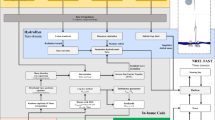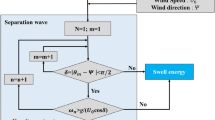Abstract
The present study conducted an analysis of waves and wind on the west coast of Jeju Island in South Korea to derive the loads for a structural analysis under operational, extreme, and survival conditions and then evaluated the structural strength of the DeepCwind semi-submersible platform of NREL for 5 MW wind turbine. As a floating structure is exposed to wind and wave loads in a highly changeable marine environment and consists of tubular joints with slender-element members, a load analysis is necessary for strength evaluation and design of the structure. The wave scatter diagrams based on KORDI’s 24-year measurements of sea states and the annual mean wind speeds were used as the operational conditions. A sea state with a period that is very likely to cause the resonance of a floating structure was applied as the extreme condition. Another sea state during the Bolaven, a typhoon passing west of Jeju Island in 2000, is adopted as the survival condition. The surface pressure distribution of DeepCwind calculate through hydrodynamic analysis was applied to a structural analysis model based on a hydrodynamic-structure interaction analysis. The evaluation of the structural strength is performed in accordance with the provisions of DNV-OS-C201 and API-2A-WSD under operational, extreme, and survival conditions.
Similar content being viewed by others
Abbreviations
- ρ :
-
Density of sea water, normally 1025 [kg/m3]
- g :
-
Acceleration of gravity [m/s2]
- ζ a :
-
Significant wave amplitude [m]
- ω :
-
Wave angular frequency [rad/s]
- k :
-
Wave number [1/m], k = ω2 / g
- x, z:
-
Horizontal and vertical CoG coordinates for the individual main items of the lifted object [m]
- η a :
-
Largest vertical single amplitude crane tip motion [m]
- ω n :
-
Circular frequency of the vertical motion of the lifted object [rad/s]
- ε :
-
Phase angle between wave and crane tip motion [rad]
- M:
-
Mass of object item in air [kg]
- A33 :
-
Added mass of object item [kg]
- C s :
-
Slamming coefficient
- AS :
-
Slamming area projected on a horizontal plane [m]
- C D :
-
Drag coefficient of object item
- Ap :
-
Area of object item projected on a horizontal plane [m2]
- H s :
-
Significant height [m]
- T p :
-
Peak period [s]
- H max :
-
Maximum height of wave [m]
- T H_max :
-
Period of max H [s]
- f h :
-
Membrane stress [Pa]
- F hc :
-
Critical hoop buckling stress [Pa]
- SF k :
-
Buckling safety factor
- C h :
-
Critical hoop buckling coefficient
- σ aN :
-
Allowable stresses at normal condition [Pa]
- σ aE :
-
Allowable stresses at extreme condition [Pa]
- SF N :
-
Safety factor at normal condition
- SF E :
-
Safety factor at extreme condition
- L :
-
Length of tubular members [mm]
- t:
-
Thickness of tubular member [mm]
- D:
-
Diameter of tubular members [mm]
References
B. Hamilton, Global offshore wind market, Wind Shipping and Logistics Conference, Copenhagen, Denmark, March 12 (2015).
J. Jonkman, S. Butterfield, W. Musial and G. Scott, Definition of a 5-MW Reference Wind Turbine for Offshore System Development, NREL (2009).
S. Lefebvre and M. Collu, Preliminary design of a floating support structure for a 5MW offshore wind turbine, Ocean Engineering, 40 (2012) 15–26.
Y. Zhao, J. Yang and Y. He, Preliminary design of a multi-column tlp foundation for a 5-mw offshore wind turbine, Energies, 5(10) (2012) 3874–3891.
A. Aubault, C. Cermelli and D. Roddier, WindFloat: A floating foundation for offshore wind turbines—Part III: Structural analysis, ASME 2009 28th International Conference on Ocean, Offshore and Arctic Engineering, American Society of Mechanical Engineers, 1 (OMAE2009-79232) (2009) 213–220.
D. Roddier, C. Cermelli, A. Aubault and A. Weinstein, Wind-Float: A floating foundation for offshore wind turbines, Journal of Renewable and Sustainable Energy, 2(3) (2010) 033104.
Det Norske Veritas, Structural Design of Offshore Units (WSD Method), Offshore Standard DNV-OS-C201 (2014).
API, R. 2A-WSD, Recommended Practice for Planning, Designing, and Constructing Fixed Offshore Platforms—working Stress Design, American Petroleum Institute, Washington, DC. (2002).
A. Robertson, J. Jonkman, M. Masciola, H. Song, A. Goupee, A. Coulling and C. Luan, Definition of the Semisubmersible Floating System for Phase II of OC4, NREL (2012).
Det Norske Veritas, Marine Operations, Design and Fabrication, Offshore Standard DNV-OS-H102 (2012).
Det Norske Veritas, Modelling and Analysis of Marine Operations, Offshore Standard DNV-RP-H103 (2011).
Det Norske Veritas, Environmental Conditions and Environmental Loads, Offshore Standard DNV-RP-C205 (2007).
K. H. Lee, S. O. Jun, K. H. Pak, D. H. Lee, K. W. Lee and J. P. Park, Numerical optimization of site selection for offshore wind turbine installation using genetic algorithm, Current Applied Physics, 10(2) (2010) S302–S306.
K. Y. Oh, J. Y. Kim, J. S. Lee and K. W. Ryu, Wind resource assessment around Korean Peninsula for feasibility study on 100 MW class offshore wind farm, Renewable Energy, 42 (2012) 217–226.
C. Luan, Z. Gao and T. Moan, Modelling and analysis of a semi-submersible wind turbine with a central tower with emphasis on the brace system, ASME 2013 32nd International Conference on Ocean, Offshore and Arctic Engineering, American Society of Mechanical Engineers, 8 (OMAE2013-10408) (2013) V008T09A024.
Det Norske Veritas, Design of Floating Wind Turbine Structures, Offshore Standard DNV-OS-J103 (2013).
O. G. Houmb and T. Overvik, Parameterization of wave spectra and long term joint distribution of wave height and period, Proceedings of 1st International Conference on Behavior of Offshore Structures (BOSS) (1976) 144–167.
Y. Goda, Random seas and design of maritime structures, 2nd Edition, Advanced Series on Ocean Engineering, World Scientific, 15 (2010).
K. C. Jun, W. M. Jeong, J. Y. Choi, K. S. Park, K. T. Jung, M. K. Kim and F. Qiao, Simulation of the extreme waves generated by typhoon Bolaven (1215) in the east china sea and yellow sea, Acta Oceanologica Sinica, 34(12) (2015) 19–28.
Y. Hwang et al., Application of wind data from automated weather stations to wind resources estimation in Korea, Journal of Mechanical Science and Technology, 24(10) (2010) 2017–2023.
S.-C. Roh and S.-H. Kang, Effects of a blade profile, the Reynolds number, and the solidity on the performance of a straight bladed vertical axis wind turbine, Journal of Mechanical Science and Technology, 27(11) (2013) 3299–3307.
W. Shi, C. W. Kim, C. W. Chung and H. C. Park, Dynamic modeling and analysis of a wind turbine drivetrain using the torsional dynamic model, International Journal of Precision Engineering and Manufacturing, 14(1) (2013) 153–159.
K. H. Lee, S. O. Jun, K. H. Pak, D. H. Lee, K. W. Lee and J. P. Park, Numerical optimization of site selection for offshore wind turbine installation using genetic algorithm, Current Applied Physics, 10(2) (2010) S302–S306.
Acknowledgments
This work was supported by the National Research Foundation of Korea (NRF) grant funded by the Korea government (MSIT) (No. 2019R1A2C1090228, No. 2019R1H1A2080082) and the Technology Innovation Program (20004627) funded by the Ministry of Trade, Industry & Energy (MOTIE, Korea).
Author information
Authors and Affiliations
Corresponding author
Additional information
Recommended by Editor Seungjae Min
Dong-chan Lee received the B.S. and M.S. degrees in mechanical engineering from Konkuk University, Seoul, Republic of Korea, in 2014 and 2016, respectively. He is currently working toward the Ph.D. degree in mechanical design engineering at Hanyang University, Seoul, Republic of Korea. His research interests are multi-physics analysis and optimal design by CAE technology.
Chang-Wan Kim received the B.S. degree in mechanical engineering, Hanyang University, Republic of Korea, in 1987. He received the M.S. degree in mechanical engineering from Pohang University of Science and Technology (POSTECH), Republic of Korea, in 1993. He received the M.S. degree in computational applied mathematics, and Ph.D. degree in aerospace and engineering mechanics from University of Texas at Austin, Texas, USA, in 1997 and 1999, respectively. He is currently a Professor of Department of Mechanical Engineering, Konkuk University, Seoul, Korea. His research interests include vibration and noise analysis, multi-body dynamics, optimal design, and multi-physics analysis.
Rights and permissions
About this article
Cite this article
Lee, DC., Cho, S., Yang, Hi. et al. Load analysis and structural strength evaluation of semi-submersible platform for wind turbines in Jeju Island sea states using hydrodynamic-structure interaction analysis. J Mech Sci Technol 34, 1227–1235 (2020). https://doi.org/10.1007/s12206-020-0221-5
Received:
Revised:
Accepted:
Published:
Issue Date:
DOI: https://doi.org/10.1007/s12206-020-0221-5




